The French AOC system, which stands for Appellation d’Origine Contrôlée, is a certification granted to certain French geographical indications for wines, cheeses, butters, and other agricultural products, under the auspices of the government bureau Institut National des Appellations d’Origine, now the Institut National de l’Origine et de la Qualité (INAO).
This label is a mark of quality that ensures the product comes from a specific region in France and adheres to strict production standards and traditional methods defined for each appellation.

For wine lovers, understanding the AOC is crucial as it not only guarantees the origin of the wine but also the grape varieties used, the winemaking process, and even the minimum alcohol level. It influences your experience of French wine, providing an assurance that the wine in your glass presents a flavor profile and quality consistent with the reputation of its region.
The system encompasses hundreds of wine appellations, each with its unique regulations, and is integral to maintaining the legacy of French winemaking traditions while contributing to the diversity of France’s wine offerings.
Key Takeaways
- The AOC label signifies that a product meets defined criteria for geographical origin and quality.
- Understanding the AOC helps ensure the authenticity and traditional craftsmanship of French wines.
- Regulations under the AOC system maintain the reputation and distinctiveness of wine regions in France.
History and Development of the AOC System
When exploring the world of French wines, understanding the Appellation d’origine contrôlée (AOC) system is paramount. This regulatory framework has played a critical role in the history of wine production and continues to shape the industry.
Origins of Wine Appellations
The concept of wine appellations in France has its roots in the Middle Ages, where the quality and reputation of wine from certain regions began to be recognized. Monastic orders like the Benedictines and Cistercians were influential in documenting and improving viticultural practices in their vineyards.
Through their meticulous record-keeping, they established informal appellations that laid groundwork for future regulation. You can learn about medieval wine traditions and the significance of monastic contributions to viticulture.
Institutionalization and Legal Framework
Formal institutionalization of wine appellations occurred in the 20th century. France established the Institut National des Appellations d’Origine (INAO) in 1935 to oversee the AOC system.
The move was aimed at safeguarding the reputation and integrity of French wines and agricultural products, setting precise regulations on how and where certain products could be produced. The creation of the AOC represented a significant legal framework, standardizing the quality and characteristics of each appellation.
Evolution Over Time
Over time, the AOC system has evolved, adjusting to technological advances and market demands. Its policies and regulations have expanded to cover not just wines but also a variety of agricultural products, ensuring that anything bearing an AOC label meets stringent production criteria. This evolution solidifies the AOC’s role as a guarantor of quality and tradition in French agri-food products.
The AOC system’s rich history continues to be a testament to France’s commitment to excellence in agriculture and winemaking.
Understanding the AOC Classification
When exploring French wines, the Appellation d’Origine Contrôlée (AOC) classification signifies the quality and region-specific standards that each wine must adhere to. This system offers you a guarantee of the wine’s origin and production processes, grounded in centuries of viticultural history.
Definition and Legal Criteria
The AOC, translated to “Controlled Designation of Origin,” is a legal framework that defines the geography and methods required for a wine to receive AOC status. Each AOC wine must come from a specified area and adhere to strict regulations regarding grape varieties, yield limits, alcohol content, and winemaking practices. These criteria are in place to protect the unique characteristics that the geography imparts to the wine.
Categories of Classification
Within the AOC system, wines are classified into categories based on their regional provenance and the quality standards they fulfill. At the top, wines may be designated as Grand Cru or Premier Cru, classifications that reflect superior quality, prestige, and often a more specific geographic origin. Below this, wines may simply carry an AOC label, ensnaring an assurance that they meet the region’s designated production and sourcing standards.
Ensuring Quality and Authenticity
In order to ensure that a wine genuinely reflects the AOC it claims, regulatory bodies carry out rigorous checks. This is where the AOC overlaps with the European Union’s Protected Designation of Origin (PDO); both work to verify and protect regional food and wine products, enforcing the quality and authenticity that you expect from high-caliber French wines.
Continuous oversight and regulation uphold these standards, giving you confidence in the label’s promise of quality and origin.
Discover how the classification impacts the wine’s characteristics through a deeper understanding of wine classification and appellations.
Geographical Indications and Terroir
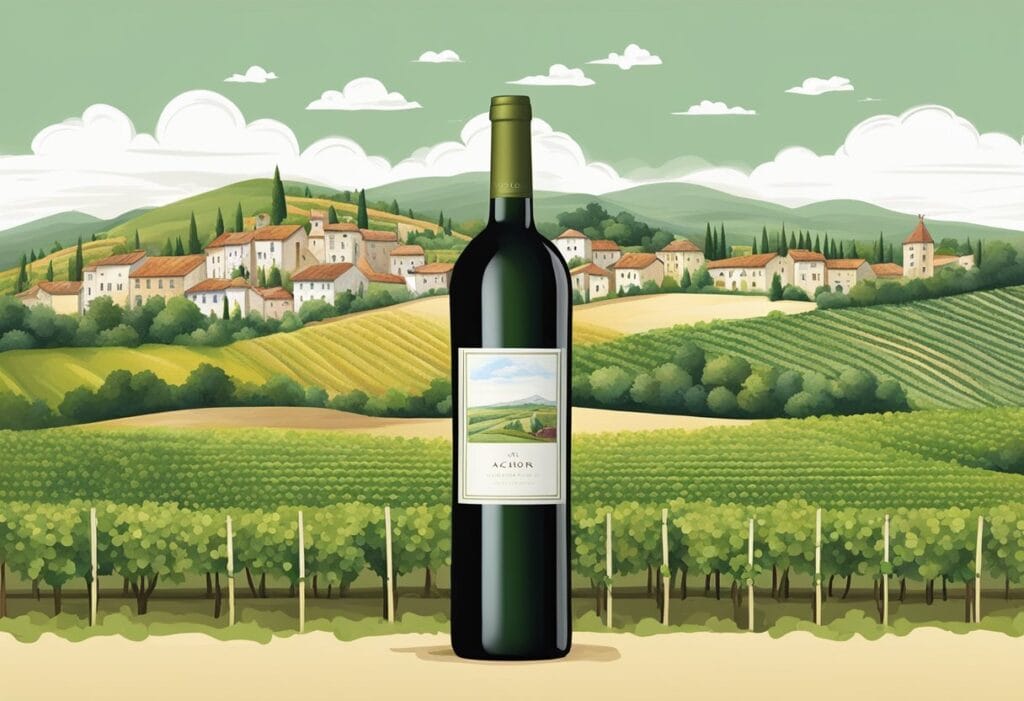
Understand the French AOC system by exploring how geographical indications (GI) intricately connect to the concept of terroir, affecting everything from vineyards to the subtleties in wine flavors.
Significance of Terroir
Terroir is a term that defines the complete natural environment in which a particular wine is produced, including factors like regional and sub-regional climate, soil, and altitude. It embodies the essence of a place, often believed to be captured in the taste and character of the wine produced. Your understanding of terroir’s significance is pivotal as it shapes the identity of wine.
GI and AOC Interplay
The AOC (Appellation d’Origine Contrôlée) principles are deeply rooted in the importance of geographic specificity. The interplay between GI and AOC aims to protect and legitimize the unique regional qualities of French wines. GIs serve as legal designators that authenticate a wine’s origins from a certain terroir, protecting the regional uniqueness and ensuring that only wines from specific vineyards meet the stringent AOC criteria.
Impact on Wine Characteristics
The characteristics of wine are profoundly influenced by its terroir. Factors like soil composition, climate, and altitude contribute to flavor profiles and textures that are distinct to a particular area. For instance, the varied climate and soil conditions within the Côtes du Rhône AOC lead to a wide range of wine styles. You can expect that a wine bearing this AOC label has met the rigorous standards that define the area’s typicity.
Major French Wine Regions and AOCs
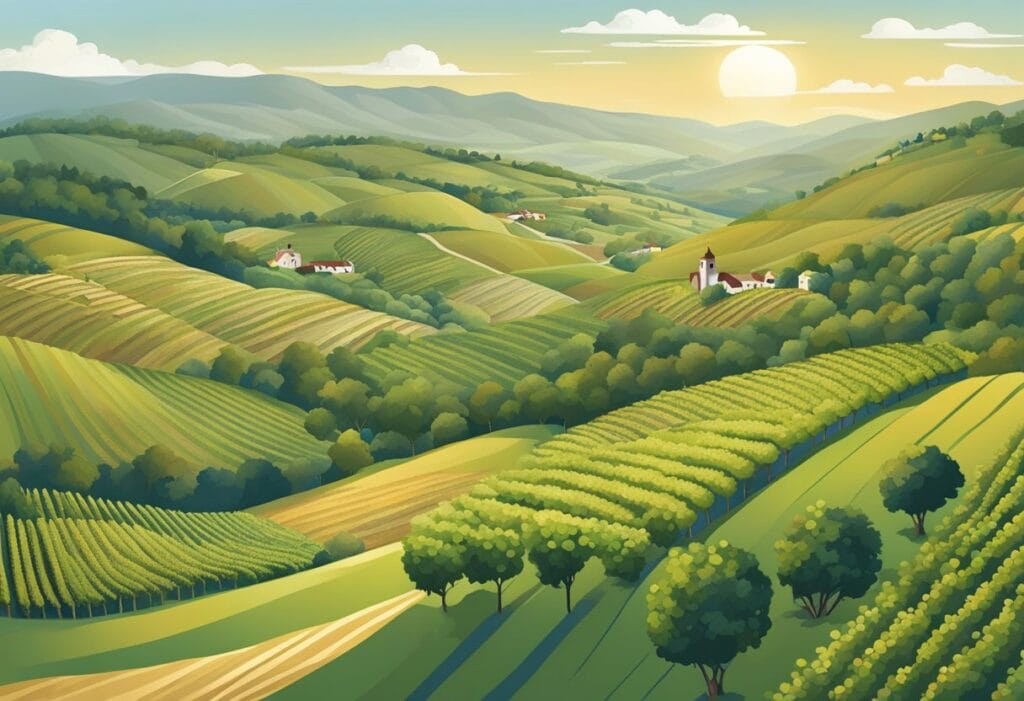
The French AOC system is a hallmark of quality that reflects the diversity and specialty of France’s wine regions. Understanding this system is key to appreciating the nuances and heritage of French wines.
Bordeaux and Its Classification
In Bordeaux, you’ll find some of the world’s most prestigious wines, with the region being famous for its strict classification system that dates back to 1855. Wines from the Médoc area frequent the top of this hierarchy, where estates like those in Pauillac produce coveted bottles. Additionally, areas like Saint-Émilion have their own classification, positioning their wines among the elite.
Sauternes, on the other hand, is renowned for its luscious sweet wines. Estates here, such as the celebrated Château d’Yquem, excel in creating rich, honeyed wines with complex flavors and longevity.
The Diversity of Burgundy AOCs
Burgundy (Bourgogne) is a mosaic of highly individualized plots known as climats, and its wines are categorized with precision from regional to single vineyard AOCs. The essence of Burgundy’s classification lies in the expression of terroir, with famous regions like Beaune contributing to the excellence of Burgundy wines. Chablis, a distinct region in Burgundy, is noted for its crisp and minerally Chardonnay.
Sparkling Wines of Champagne
The Champagne region is the birthplace of sparkling wines that have set the global standard. This region’s AOC regulations ensure the traditional méthode champenoise is adhered to, preserving the distinctive effervescence and quality of true Champagne.
Unique AOCs in Alsace and Loire
Heading to Alsace, you encounter a unique AOC setup influenced by both French and German winemaking traditions, where varieties like Riesling and Gewürztraminer flourish. Similarly, the Loire Valley offers a diverse portfolio of wines, ranging from zesty Sauvignon Blanc in regions like Sancerre and Pouilly-Fumé to the mellow and sweet dessert wines of regions like Vouvray.
Other Notable Regions
Do not overlook other significant regions like Languedoc and Rhône. Languedoc is known for its IGP wines, offering some of the most value-oriented yet quality-driven wines in France. The Rhône Valley is celebrated for its robust red wines, where appellations like Châteauneuf-du-Pape utilize blending practices to create complex and hearty wines.
The AOC System Beyond Wine
The Appellation d’Origine Contrôlée (AOC) certification extends its rigorous standards beyond wine, safeguarding the quality and tradition of a variety of French agricultural products.

AOC for Cheeses and Other Foods
AOC certifications are integral to maintaining the legacy and authenticity of French cheeses. When you buy an AOC-labeled cheese, you’re getting a guarantee that the cheese has been produced according to stringent guidelines.
These rules dictate everything from the types of grass cows may eat to the minimum aging process. Protected Designation of Origin (PDO) is a similar European Union designation that parallels the AOC standards, ensuring that agricultural food products are uniquely linked to their place of origin.
- Examples of AOC French cheeses include:
- Roquefort
- Camembert de Normandie
- Brie de Meaux
In addition to cheese, the AOC status covers a range of other food items, each with their unique regional characteristics that are worthy of protection and recognition.
Expansion to Broader Agriculture
The scope of the AOC and PDO isn’t limited to just cheese and wine. Your experience with agricultural products carrying these labels means you’re indulging in a piece of regional heritage, reflecting traditional practices and the local environment. The AOC ensures that everything from the climates where the trees grow, to the cultivation methods used, adhere to historical principles.
- Agricultural products with AOC recognition include:
- Puy lentils
- Provence honey
- Espelette peppers
Each product under the AOC certification is a testament to France’s dedication to preserving the unique qualities and methods inherent in their national gastronomy.
Regulatory Bodies and Enforcement
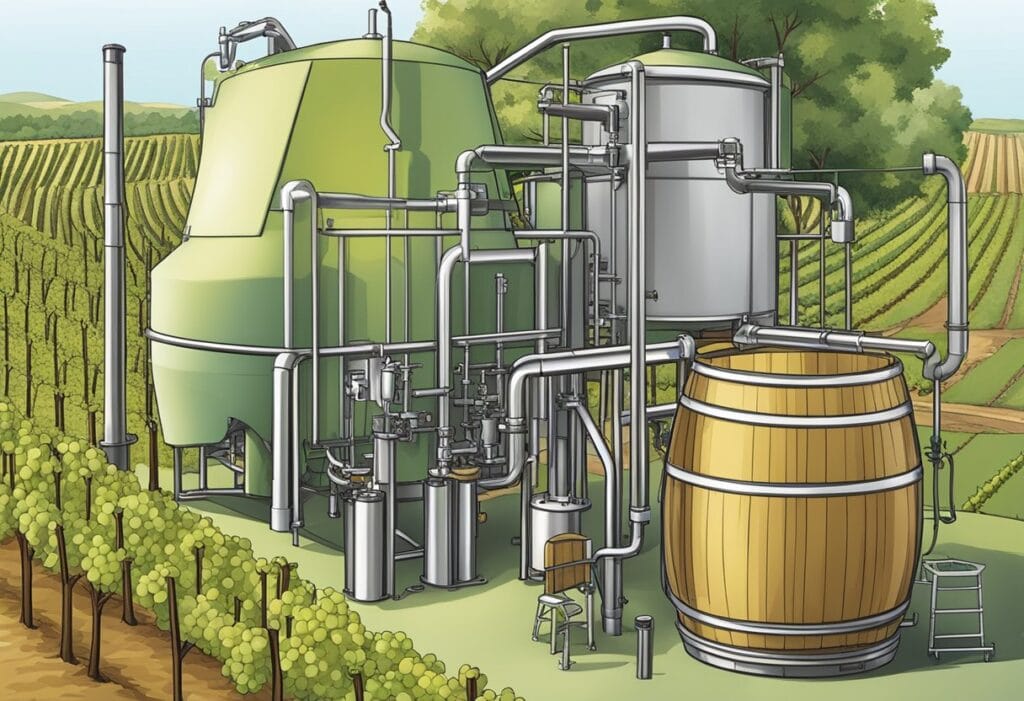
Understanding the French Appellation d’origine contrôlée (AOC) system requires recognizing the roles of regulatory bodies and how they enforce these quality standards. This enforcement helps maintain the integrity of French agricultural products.
Role of INAO
The Institut National des Appellations d’Origine (INAO) is a public institution under the French Ministry of Agriculture. It is tasked with overseeing the AOC regulations and ensuring compliance. The INAO establishes the link between products and their geographical origins, setting the rigorous standards that producers must meet.
Legal Protections and Controls
French law provides legal frameworks to protect the appellations. Strict legal controls are in place, underpinned by AOC regulations that define the geographic boundaries for production and the methods required to meet these coveted designations. These laws safeguard the traditional techniques and quality expectations that are synonymous with French terroir.
Combatting Fraud and Misuse
Fraudulent use of AOC labeling is a serious offense, with regulatory bodies actively combatting fraud through surveillance and legal action. This vigilance ensures consumers receive authentic products and that producers adhere to the high standards set by the INAO. Continuous efforts in regulation and control play a pivotal role in maintaining France’s agricultural reputation.
Global Influence and Comparative Systems
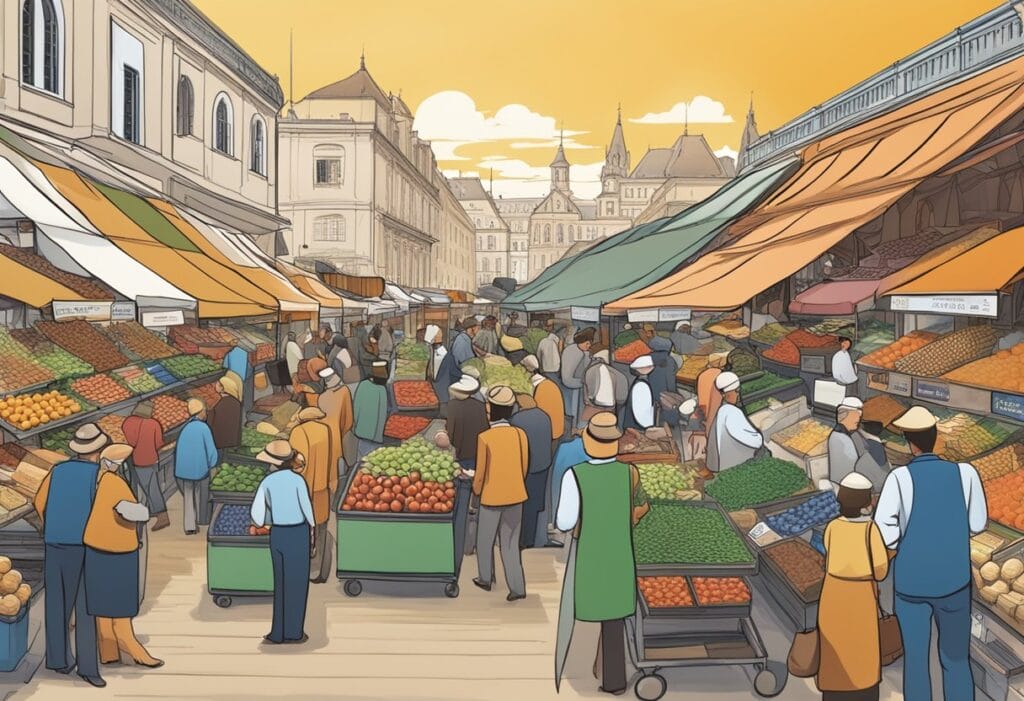
The French AOC system has not only shaped local wine production but also influenced international standards and appellation systems worldwide.
AOC’s Role in EU Legislation
Under the European Union’s agricultural policy, the Appellation d’Origine Contrôlée (AOC) framework serves as a cornerstone for protecting regional food and drink products.
This has paved the way for two key forms of certification: the Protected Designation of Origin (PDO) and the Protected Geographical Indication (PGI), known in France as the Indication Géographique Protégée. You’ll find that the EU’s embrace of these standards reflects the rigor and structure of the French system.
Comparative Appellation Systems
While Italy and Spain have developed their appellation systems, inspired by the AOC, they have distinct titles like Denominazione di Origine Controllata (DOC) in Italy and Denominación de Origen (DO) in Spain. These systems closely align with the AOC’s methods and serve to maintain high-quality standards and authenticity, much as France does with its renowned Appellation d’Origine Contrôlée.
Global AOC and GI Recognition
The impact of the French AOC reaches beyond Europe, setting precedents for appellation systems in countries like America. Although the U.S. recognizes geographical indications to a lesser extent, there is increasing acknowledgment of the value such certifications add to products.
The international recognition of geographical indications suggests that systems similar to the AOC are significant in the global marketplace, underpinning the importance of place and tradition in food and drink production.
Challenges and Future of the AOC System
In facing its challenges and steering towards the future, the AOC system must navigate market demands, climate volatility, and the balance between tradition and innovation with strategic agility.
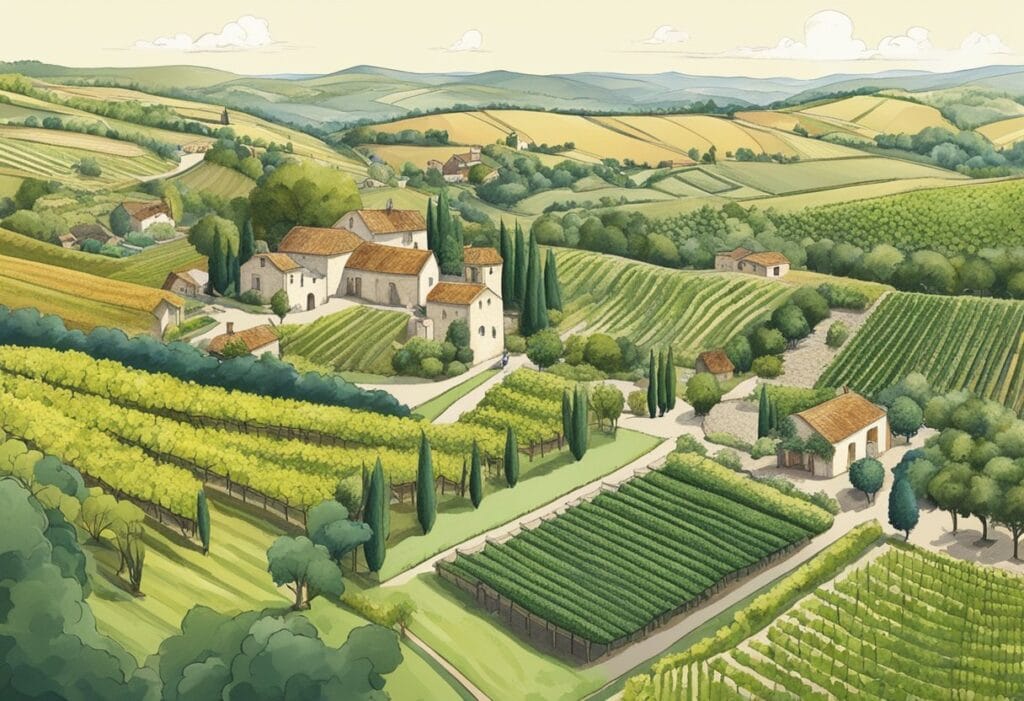
Adapting to Market Trends
The global market is continuously evolving, creating both opportunities and challenges for the wine industry, especially regarding quality wines produced in specified regions. As consumer preferences shift, your commitment to upholding the AOC’s stringent standards can sometimes be at odds with the lure of the global market’s vibrant segments. Aligning the AOC rules to these changing tastes while maintaining the integrity of the winemaking tradition is pivotal.
Addressing Climate Change
Climate change is an undeniable force, altering the environmental variables that have historically defined the terroirs of France. These changes necessitate adaptative production techniques in vineyards and wineries, all while striving to adhere to AOC specifications. Embracing practices that reflect an understanding of the changed climate conditions, without diluting the essence of what makes an AOC wine distinct, is a tightrope walk you’re tasked with managing.
Technological Advancements and Tradition
Innovation in winemaking and production is on a constant rise. How you integrate technological advancements that improve quality and efficiency while preserving time-honored methods is a critical decision point for the AOC system. It’s essential to discern between beneficial innovations that enhance quality and those that may compromise the authenticity and reputation of AOC wines in the global market.
AOC and Consumer Choice
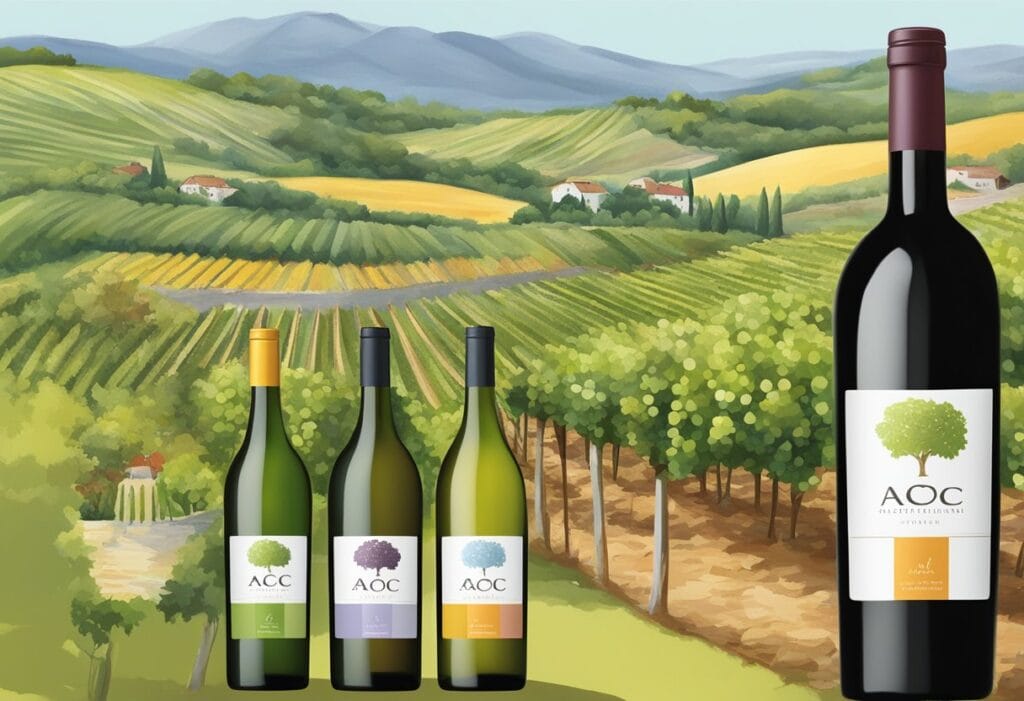
When you select a bottle of wine, the Appellation d’Origine Contrôlée (AOC) label serves as an assurance of quality and authenticity. This section explores how the AOC impact affects your choices as a consumer.
Impact on Purchasing Decisions
You might notice that wines with an AOC label often catch your eye in a store. This is no accident; the presence of an AOC designation often implies a higher standard of wine, influencing your purchasing decisions.
Wines labeled as AOC must adhere to stringent regulations regarding grape varieties, winemaking practices, and geographic origin. These criteria are designed to ensure that each AOC wine is a true representation of its terroir, thereby promising a certain level of quality.
Marketing and Labeling Influence
The marketers understand the power of branding. For you as a consumer, AOC serves as a powerful tool in branding and marketing French wines. The terminology and emblems associated with the AOC act as markers of prestige, guiding your selection process. When you are presented with a bottle that boasts an Appellation d’Origine Contrôlée label, it communicates a message of exclusive heritage and meticulous crafting.
Educating the Wine Consumer
Part of the value in AOC labels lies in their ability to educate you about wine. As you become more familiar with these labels, you learn to associate certain regions with specific wine characteristics. For instance, understanding the significance of a Champagne AOC can further inform your appreciation and knowledge of the diverse winemaking practices and regional profiles that France has to offer.
Through these AOC guidelines, you gain insight into the legacies of French viticulture, equipping you with the knowledge to make informed decisions about the wines you choose to enjoy.

